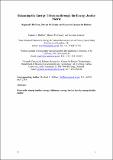Files in this item
Balancing the energy trilemma through the Energy Justice Metric
Item metadata
| dc.contributor.author | Heffron, Raphael | |
| dc.contributor.author | McCauley, Darren | |
| dc.contributor.author | Zarazua de Rubens, Gerardo | |
| dc.date.accessioned | 2019-08-27T23:39:43Z | |
| dc.date.available | 2019-08-27T23:39:43Z | |
| dc.date.issued | 2018-11-01 | |
| dc.identifier | 255597316 | |
| dc.identifier | 8b0c012f-7bfa-4b9d-a4a8-2b5282f88f56 | |
| dc.identifier | 85052300040 | |
| dc.identifier | 000449891500092 | |
| dc.identifier.citation | Heffron , R , McCauley , D & Zarazua de Rubens , G 2018 , ' Balancing the energy trilemma through the Energy Justice Metric ' , Applied Energy , vol. 229 , pp. 1191-1201 . https://doi.org/10.1016/j.apenergy.2018.08.073 | en |
| dc.identifier.issn | 0306-2619 | |
| dc.identifier.uri | https://hdl.handle.net/10023/18381 | |
| dc.description.abstract | Energy justice is a fast emerging research and policy tool which captures the injustices across the energy life-cycle, i.e., from ‘cradle-to-grave’. The Energy Justice Metric (EJM) quantifies energy justice through analyzing the energy justice performance of different countries utilising data from international institutions and national governments. This paper identifies why there is a need for a modeling tool such as the EJM which focuses on the full energy life-cycle and also has a distributive (inequality-correcting) oriented approach. The EJM demonstrates how a country can achieve an improved balance between the three competing aims of the energy trilemma, i.e. economics, politics and the environment. A key feature of the EJM is modeling energy justice using a ternary plot where the energy justice performance of a country can be transferred directly onto the energy trilemma. In this paper, five countries are analysed, the US, UK, Germany, Denmark and Ireland. The EJM presents a research and policy decision-making tool that can contribute to the growing literature that tackles the issue of inequality in society, and informs on society’s decision on which energy source would be more just for a society to build. | |
| dc.format.extent | 11 | |
| dc.format.extent | 927282 | |
| dc.language.iso | eng | |
| dc.relation.ispartof | Applied Energy | en |
| dc.subject | Energy justice | en |
| dc.subject | Energy trilemma | en |
| dc.subject | Energy justice metric | en |
| dc.subject | Distributive justice | en |
| dc.subject | Energy economics | en |
| dc.subject | Societal inequality | en |
| dc.subject | G Geography (General) | en |
| dc.subject | 3rd-NDAS | en |
| dc.subject | SDG 7 - Affordable and Clean Energy | en |
| dc.subject.lcc | G1 | en |
| dc.title | Balancing the energy trilemma through the Energy Justice Metric | en |
| dc.type | Journal article | en |
| dc.contributor.institution | University of St Andrews. School of Geography & Sustainable Development | en |
| dc.identifier.doi | 10.1016/j.apenergy.2018.08.073 | |
| dc.description.status | Peer reviewed | en |
| dc.date.embargoedUntil | 2019-08-28 |
This item appears in the following Collection(s)
Items in the St Andrews Research Repository are protected by copyright, with all rights reserved, unless otherwise indicated.

